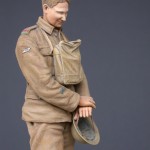
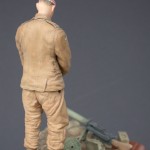
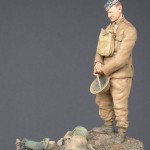
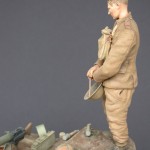
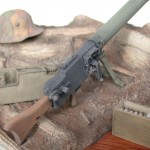
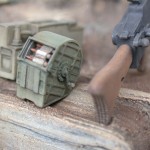
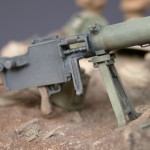
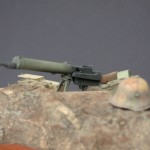
Private, 4th Battalion Tank Corps 1918 with Captured 08/15 MG
- Scale / Maßstab: 1/16th (120mm)
- Material: Resin (figure), Model Plaster (base) / Resin (Fugur), Modell-Gips (Sockel – synethetische, kunststoffveredelte Gießmasse)
- Parts / Teile: 30
- Infosheet / Infoblatt: English
- Code / Artikel-Nr.: 10TFb
- Attention: Not a toy. Model kit or model making accessories – not suitable for children under 14 years of age. / Achtung: Kein Spielzeug. Modellbauzubehör – nicht für Kinder unter 14 Jahren geeignet
GPSR Data / Angaben
- Manufacturer / Hersteller: Jon Smith Modellbau
- Responsible Person / Verantwortliche Person
- Address: Hannoverstr. 68, 29664 Walsrode, Germany
- Contact / Kontakt: info@jonsmith-modellbau.com
- Tel: +49 (0)5161 8255
Contents:
- Figure (8 parts) / Figur (8 Teile)
- 2nd Alternative Head with Glengarry / 2. Alternativ-Kopf mit Glengarry
- Small Box Respirator Bag / Gasmasketasche – Typ Small Box
- British Steel Helmet MK1 / Bt. Stahlhelm Mk1
- Model Base / Modell-Sockel
- Machine Gun 08/15 / Maschinengewehr 08/15 (3 parts)
- Standard MG 08/15 Bipod / MG08/15 Zweibein
- Steam Hose / Dampf-Schlauch
- Double-Ended Metal Spare Barrel Container for MG08 / Ersatzlaufbehälter für 2 Rohre MG08
- Drum Magazine – Trommelmagazine, or the official name: Patronenkasten 16 (2 parts / Teile)
- 2 Wooden Ammunition Boxes M1901 / 2 Patronenkasten aus Holz M1901
- Wooden Ammunition Box M1901 – Open (3 parts) / Patronenkasten aus Holz M1901 – Offen (3 Teile)
- Steam Condensing Can new type (2 parts) / Kühlwasserbehälter neuer Art (2 Teile)
- Ammunition Belt
- 2 Stick Grenades M1915 / 2 Stielhandgranaten M1915
- Steel Helmet M1916 / Stahlhelm M1916
Below are photos of my own painted figure, with the wooden plinth cut out to enable the German trench revetment supplied to be extended further downwards. The last part of the trench revetment with shelf is not included in this figure diorama.
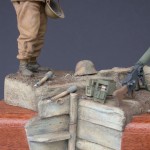
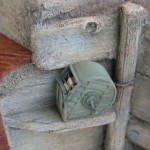
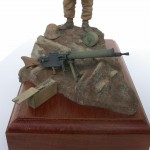
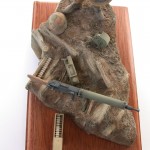
Extracts from the Infosheet with this figure:
The figure depicts a private, 4th Battalion (originally D Company, later A Battalion), Tank Corps, France 1918. A young man, standing relaxed holding his blue painted steel helmet. The original photograph shows him standing with 4 other comrades beside a male British Tank inspecting a capture German anti-tank rifle. On his service dress he wears the blue sewn on shoulder tally colours of the 4th Bn. The small-box respirator hangs in the alert position in front of the chest.
The Tank Corps formed in May 1916, was designated the Heavy Section, Machine Gun Corps and then in November of the same year became the Heavy Branch. Not until July 1917 did it eventually become the Tank Corps. Formed from volunteers, it had up until 1917 no badge of its own. The white worsted MK1 tank badge (this was a male tank with 57mm cannons – the female tank had only machine guns) issued on the 7th May 1917 was worn on the upper right service dress sleeve. By the end of the war the Tank Corps had 26 numbered battalions, along with various workshop and support units.
Head 1: This is the head of the soldier taken from the original photograph. If one holds the head in front of a light, then it is possible to see where parts of the hair have been modelled thinly – notably the wave of hair hanging down between the left eye and ear and directly above. These thin areas can be removed using a sharp blade giving the hair an extra lightness.
Head 2: Here I have tried to acquire a slightly rougher / working-class look on the face of this young Scotsman. He wears the traditional Glengarry of the Scottish infantry regiments. Also known as the Glengarry bonnet or cap this brimless form of headdress was invented by Alasdair Ranaldson MacDonell of Glengarry and made out of a thick-milled woolen material with a bobble, or toorie on top and 2 ribbons hanging from the rear.
In 1914 all Scottish infantry regiments, except the Cameronians (Scottish Rifles) and Scots Guards wore the dark blue Glengarry (on many photographs this dark blue will nearly always appear black). The border or band had a red, black and white dicing with the brass regimental cap badge mounted onto a black silk background or rosette. The toorie (bobble) has a different colour depending on regiment. The cap badge is of the Argyll and Southern Highlanders – a Stag’s Head above the motto CUIDICH’N RIGH (Help the King).
The regiment was originally formed by the amalgamation in 1881 of the old 78th or Seaforth’s Highlanders, later the 72nd Highlanders (Duke of Albany’s Own), and the 78th or Ross-shire Buffs. During World War 1 the regiment was made up of 19 battalions and saw action on the Western Front, Mesopotamia, Macedonia and Palestine. Only the 1st and 2nd battalions were regulars, the others consisted of the Special Reserve, Territorial and War Service Battalions.
Today apart from Scottish regiments serving with the British Army the Glengarry is also worn by civilian pipe bands and as an appropriate headdress by any male highlander. There is also an Irish Glengarry. The method of wearing the Glengarry during this period was to have it sat at an angle on the head, with the right side nearly touching the ear. Nowadays it is worn more or less squarely on the middle of the head.
Machine Gun 08/15 / Maschinengewehr 08/15: Germany’s first light machine gun – Maschinengewehr 08/15 entered service in the second half of 1916 and was available in greater numbers from 1917 onwards. Sir Hiram Maxim invented the first machine gun, and the original was patented in 1883. The need for an increase in the volume of fire, particularly in the attack and defending newly won ground, led to this somewhat cumbersome and heavy LMG. It was in reality a scaled-down version of the original MG 08, incorporating many interchangeable parts. To decrease the weight the constructors reduced the water capacity of the cooling jacket from 4 to 3 litres, redesigned the box receiver and removed the mount for the ZF12 telescopic sight. A pistol grip in place of the double-handed spaded grips and a wooden rifle type shoulder stock were added along with a lightweight bipod. A new flash hider (muzzle booster/flash suppressor) was introduced to give a better recoil action. The savings resulted in a portable MG, still weighting 43 lbs. (19.5 Kg), but with the advantages of some interchangeable parts, same function, rate of fire, ammunition (belt fed, but of different types), similar training for crews already rehearsed on the MG 08 and ease of production at the same factories.
Conflicting accounts for the correct amount of crew, or Trupp for the MG 08/15 appear to vary between 3 and 4 (2 x trained gunners and 1 or 2 ammunition carriers). A second Trupp consisting of 7 riflemen and section commander could back up this MG Trupp, or section. The two Trupps would form a Gruppe, the object being to defend the MG at all costs. It was possible with the aid of a leather sling and the 100 round drum magazine for the gun to be carried and operated by a single gunner. During firing the crank handle moves in a half cycle forwards and backwards.
Note: the separate crank handle can be attached to the rear right side of the MG block and fixed in the required position. Also, using a small drill and a knife it is possible to hollow out the space inside the breach block, allowing for the ammunition belt to be placed into the opening – here the resin has been cast as thin as possible. This can also be applied to the inside of the forward and rear sling attachment (under the barrel jacket and within the wooden stock).
The term 08/15 (spoken ´Null Acht Funfsehn´) is used in the German language to describe anything, which is ordinary, simple / crude, or to describe something senseless and apparently derived from this MG. Colour: the wooden pistol grip and shoulder stock were of a hard dark wood. The water jacket was either dark green or painted in the many different German outlined-camouflaged patterns seen on late-war steal helmets – this was in fact an official directive from the High Command, but judging from original photos seems not to be too widespread. All other parts are dark gunmetal.
Standard MG 08/15 Bipod / MG08/15 Zweibein: This entirely new pressed-steel lightweight bipod was to replace the large and heavy sled mounts used with the MG 08 and allowed for a 180° traverse. It had a universal attachment fitting, which could be fitted to the Mauser T-Gewehr – Mauser anti-tank rifle. Colour: dark green.
Note: this should fit to the MG bipod attachment. Under the release leaver (top rear of bipod) there is a small casting web – this should be removed before painting etc.
Double-Ended Metal Spare Barrel Container / Ersatzlaufbehälter für 2 Rohre MG08 oder 08/15: Designed to carry two spare barrels and a cleaning rod. This was an essential piece of equipment with the high rate of fire achieved by this weapon. Barrel changing was an important part of the training and could even be achieved whilst the barrel jacket was still full of water. Colour; grey-green with pale coloured cloth straps and reinforced leather fastener holes.
Drum Magazine / Trommelmagazine: The side mounted drum magazine (or the official name: Patronenkasten 16) made out of sheet metal and incorporating a 100 round ammunition belt enabled the operating of the gun from the slung position by a single gunner. This magazine weighed fully loaded 3.17 Kg and was attached to the receiver by means of a bracket. The small handle on the rear face had to be lifted into the up position during firing to disengage the internal drum ratchet (on the model the handle is in the locked position, preventing the belt from unwinding itself). Normal allocation per gun would be 2 drum magazines, delivered in a wooden box. The round openings at each side of the drum are the actual rotating spindle (2 small discs). Colour: dark green. Discs – metal.
Note: looking into the top one can see 2 rounds cast into the bottom of the hole. On top of these can be placed the 3 separate rounds (1 set is spare) to indicate a full magazine. A casting web is attached to the handle enabling a better flow of resin – this will need to be cut away.
Drum (Magazine) Bracket: A separate detachable bracket (+ 1 spare) is supplied with the MG to support the drum magazine. On many original photos this seems to have always been attached to the MG, regardless if drum fed or from ammunition boxes.
Note: for the correct fixing of the bracket there is an indent and small ledge under the MG feed-block. For ease of casting the recess holes within the bracket have been filled, the outside edges still visible – theses can of cause be drilled out.
Wooden Ammunition Box M1901 / Holz Patronenkasten M1901: The wooden ammunition box held a 250 round woven cotton belt with brass spacers and was used for both the MG08 and the MG08/15 (although the belts were different and not interchangeable). A push-in fastener held the lid closed with the metal handle folding into the crevice of the lid. Early models had brass handles, hinge fittings etc., later these were produced in steel. Colour: The boxes, which I had looked at had been painted originally in grey-green, with of cause the edges to the boxes quite worn. Stenciled on the lid in black were sometimes a single arrows, indicating the direction that the box should be placed next to the MG.
Note: one ammo box supplied has a detachable lid – the strips of ammunition can be painted separately and placed inside the open box afterwards. The last / top inlay has the brass bound feed tab. Plywood was used in making the original master ammunition box in order to maintain the wood grain surface on the model structure.
Ammunition Belt: The woven cotton belt with brass spacers and rounds in caliber 7.92mm. Different types of ammunition used were: standard ball, armoured- piercing and armoured-piercing tracer (1 every 10 rounds) the belts had a tendency to swell out when wet, loosening the rounds and sometimes causing stoppages. Colour: cotton belt – khaki or light yellow / brown. Case spacers – brass. Round heads – copper.
Rubber Steam Hose / Dampfschlauch: The 2 m rubber steam hose would be attached into the top of the water jacket and is to extract the vaporized water, which is then collected within the water container / can. Firing from a trench, or fixed position the MG crew, provided that they had a sufficient water supply, would bury the end of the hose to one side of the gun and thus avoid the rising white plume of steam giving their exact position away. The condensed steam can if necessary be reused to refill the water jacket. Colour: varied in colour from grey to dark matt coloured rubber – not quite black.
Water Container / Wasserkasten 15: The new type water container was used to collect the condense steam generated by the sustained firing of the MG and refill the cooling jacket afterwards. The swivel spout could be turned back into the recess of the can enabling better storage when not in use. Colour: The water cans, which I had looked at, had been painted originally in different grey-greens. Like the wooden ammunition boxes these show considerable wear and tear on outside edges.
Steel Helmet M16 / Stahlhelm M.16: This helmet, which first entered service in 1916 during the initial stages of the battle of Verdun was designed by Professor Friedrich Schwerd and made from high quality chrome-nickel steel. Weighing between 950 and 1200g, depending on size – more heavier than the Allied helmets, but giving a better protection to the face, ears and neck. The horn venting bolts on each side enabled the fitting of an extra armoured shield over the helmet (also available in 1:16th scale from Jon Smith Modellbau) for sentries, MG troops, snipers or other particularly exposed / dangerous employment. This weighing around 2000g was seldom used; although a total of 50000 were supposedly produced.
Colour: issued in field- grey, which would reflect in sun light and proved unsatisfactory. Various trials were carried out, but it was not until July 1918 that an official camouflage scheme in brown and green sharp-edged irregular patens, all outlined in black was introduced. These were carried out by unit maintenance workshops (other weapons and equipment, particularly artillery pieces and MGs were also rendered in the same way). It seems that helmets were re-painted by individuals or units in a variety of colour schemes before the official order and items with red- brown, ochre (brownish- yellow), green and blue- grey, all outlined in black were common. Helmets were also covered using the light brown sandbag material, or the issued helmet-covers, seen particularly in the later war period.
The M.17 & 18 helmets followed with only slight differences to the inside padding and chin strap fasteners. The last model to see service during the war, if only in small numbers was the M.18 Ohrenausschnitt, or Helmet M.18 with ear cut-outs (also available in 1:16th scale from JSM), more commonly (and stubbornly) known as the Cavalry or Telegraph Helmet. The cut-outs were in fact a further design feature of the M.18 to improve the hearing ability of the wearer and avoid the hissing noise experienced by troops.
The resin chin strap supplied (a 2nd reserve strap is also supplied) can be formed around the figure’s head using the application of heat (either hot water or hairdryer, holding of cause with tweezers etc.). One may want to thin out the strap before application. The length of strap will need shortening, using the finished head / helmet already completed. Alternately, one can use the brown card supplied, which can represent leather or material chin straps etc. Cut the card approx. 1.1 mm wide and 25 mm long and flatten or rub down on a hard surface with a blunt tool (handle of a modelling knife is ideal). Bend the strip around a pencil to give a natural curve, cut ends to match length and glue into position on the figure. The colour, thickness and texture achieved from rubbing down the card gives a good reproduction of leather in this scale.
Stick Grenade / Stielhandgranate M.15: The second type of German stick grenade to be issued (in greater numbers from 1916 onwards). The turned wooden handle would have the fuse duration stamped on one side, along with the makers name and production date. This grenade had the advantage of a screw cap, covering the porcelain ball and pulls cord igniter-system inside, keeping it dry and free from dirt. Most stick grenades were set with a 5.5 or 7-second time delay. The cap crown has 8 knurled indents to enable a better grip in wet/muddy conditions, or when wearing cloves. The metal clip on the side of the explosive charge is for attaching to equipment etc. On some original photos it can be seen that the screw caps have already been removed, ready for instant use if needed. The original master model was made using a fine grain wood to reproduce the surface of the handle. Colour: Metal parts – green/grey. Wooden stick/handle – untreated wood starts turning grey after a length of time when exposed to the elements.
Note: with a bit of care and a thin, sharp blade it is possible to hollow out the gap behind the clip and the explosive charge, not forgetting to leave the bottom part of the clip still attached.
 An deutschsprachige Interessenten:
Sie können mich per eMail oder Telefon auch gerne auf deutsch kontaktieren. Ortsbesuch ist nach Absprache möglich.
An deutschsprachige Interessenten:
Sie können mich per eMail oder Telefon auch gerne auf deutsch kontaktieren. Ortsbesuch ist nach Absprache möglich.
